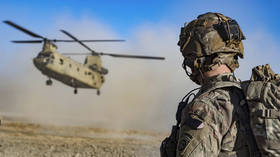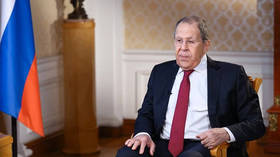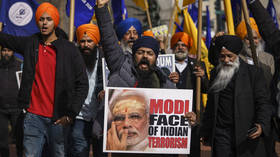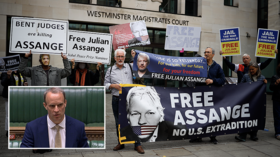‘The Russians paid bounties to the Taliban to kill US troops,’ screamed the NYT. Now it quietly admits there’s, erm, zero evidence
Is this how journalism is supposed to work in America? That you can make – or, more accurately, make up – lurid allegations, and then keep running with them even when there’s no proof at all?
What does a newspaper do when it publishes a supposed “bombshell” story and then discovers that, erm, there is actually zero evidence for it?
Well, if you are the New York Times, it appears that you quietly bury a story admitting to this on page 19 – but make it so opaque that even the most diligent reader would be unlikely to make it to the last paragraph, which is where, ever so quietly, you make your confession.
It was bad enough that their original story – alleging that US intelligence agencies believed payments were made by the Russian foreign military intelligence GRU to Afghan fighters as “bounties” for killing US soldiers in Afghanistan – was based on anonymous sources.
Then we had to endure other mainstream media outlets picking up the story, after apparently having it confirmed by other anonymous sources. As one veteran military writer in the US succinctly put it, “I'm not sure that anonymous sources confirming what other anonymous sources said actually proves anything.”
Finally, seven days after its ‘scoop’, the NYT ran another story on the subject, entitled ‘New Administration Memo Seeks to Foster Doubts About Suspected Russian Bounties’, which was published on July 3 and buried in the bowels of the paper.
Its opening paragraphs sought to back up the original story, claiming that an intelligence memo had said the “... CIA and the National Counterterrorism Centre had assessed with medium confidence – meaning creditable sources and plausible, but falling short of near certainty – that a unit of the Russian military service, known as the GRU, offered the bounties.”
‘No explicit evidence’
It was only in the last paragraph that the real story – that there was no story – was revealed: “The agency did intercept data of financial transactions that provide circumstantial support for the detainee’s account, but the agency does not have explicit evidence that the money was bounty payments.”
Let me just repeat this: “... the agency does not have explicit evidence that the money was bounty payments.”
So there is no proof – nothing, nada, zilch – to back up the original ‘bombshell’ story. The story that further soured relations between Washington and Moscow, that caused a storm of comment following its publication, and that sparked a political scandal over whether or not President Trump had, as claimed, been briefed on the ‘bounty killings’ and had “failed to act.”
According to the NYT now, however, the US intelligence memo apparently states that its spies had reports of GRU members meeting with leaders of “a Taliban-linked criminal network,” and that “money was transferred from a GRU account to the network.”
It added: “After lower-level members of that network were captured, they told interrogators that the Russians were paying bounties to encourage the killings of coalition troops, including Americans.”
However, the intelligence officials interviewed by the NYT are stressing that “the government lacks direct evidence of what the criminal network leaders and GRU officials said at face-to-face meetings, so it cannot say with any greater certainty that Russia specifically offered bounties in return for killings of Western soldiers.”
Also on rt.com Trump resumes attack on NYT’s ‘Russian bounty’ story, says 'secret source probably doesn't even exist'Moreover, even this damning testimony from the detainees was called into question by the memo, as the intelligence sources said the National Security Agency “did not have surveillance that confirmed what the captured detainees told interrogators about bounties,” according to the NYT interlocutors.
‘Fostering doubts’
Why would you bury the conclusion that the agency had no evidence that money was paid as bounties at the very end of the piece? When the lede of the article claimed the exact opposite, albeit couched in speculative terms:
“A memo produced in recent days by the office of the nation’s top intelligence official acknowledged that the CIA and top counterterrorism officials have assessed that Russia appears to have offered bounties to kill American and coalition troops in Afghanistan, but emphasized uncertainties and gaps in evidence, according to three officials,” the article began.
The headline of the piece can also be questioned, as it suggests that the memo “seeks to foster doubts” when all the memo does, as reported by the NYT, is to actually foster doubts about the veracity of the earlier report by concluding explicitly that the agency has no concrete evidence for the payments whatsoever. The missing evidence does not constitute “gaps,” as the NYT wrote, but a “total absence of evidence” in what has been a high-profile and politically incendiary report.
Russia watchers have been sceptical about the bounty hunters report from the start, which was based on a single set of anonymous quotes from intelligence agents, and offered no concrete evidence whatsoever.
While I don’t have a problem with the idea that GRU agencies are operating in Afghanistan, and may be offering money to Taliban fighters, it is the specificity of the word that the payments were for “bounties” that is the issue. Without this word, the story becomes: “GRU funds anti-American fighters in Afghanistan,” which doesn’t sound surprising. It's the evocation of the Wild West era of lawlessness that the word “bounty” carries, especially to Americans, that strongly suggests it was chosen on purpose and for effect. The reaction to the “bounty” story was almost entirely predictable, as it effectively buried the discussion of other, more plausible, explanations, of which there are plenty.
Alternative explanations
“What to make of the current claims that Russia paid the Taliban bounties to kill US and allied soldiers in Afghanistan? Both Moscow and the Taliban deny it, while claims of new evidence surface. It is still hard to understand any reason for the Kremlin to take such a dangerous step, though – and a possible alternative explanation for what evidence has been presented,” British security services expert Mark Galeotti wrote in an opinion piece for the Moscow Times.
Briefly, Russia has its own interest in Afghanistan and is afraid of the spread of both drugs and extreme Islamic terrorism from there into its soft underbelly, via Central Asia. Russia is the biggest consumer of Afghanistan’s heroin, which is another plague that has wracked Russia’s industrial hinterland. What goes on in Afghanistan is a serious domestic social and political issue for the Kremlin.
“These hard-nosed Afghan warlords do not cooperate with Moscow out of altruism or good-neighbourliness. In today’s Afghanistan – just as the British and the Russians found during the ‘Great Game’ of the nineteenth century – alliances are bought with blood, arms, and cash. Certainly, the US has not shied away from such pragmatic behaviour,” Galeotti said.
The Kremlin vehemently denied the story. “Maybe I can sound a little rude, but this is 100% bulls**t,” Russian presidential spokesman Dmitry Peskov said. “As far as I’m concerned, none of America’s representatives has ever raised this question against Russian representatives.”
More tellingly, the Taliban officially denied the reports, saying to accept bounty payments would encroach on Afghanistan’s sovereignty.
“Our target killings and assassinations were ongoing in years before, and we did it on our own resources," Zabihullah Mujahid told the NYT. He added that the Taliban had stopped attacking US and Nato forces after they agreed in February to a phased troop withdrawal and to lift sanctions. In return, the Taliban said they would not allow extremist groups to operate in areas they control.
One of the few pieces that attempted a follow-up to confirm the NYT was a poorly sourced report by Business Insider. The publication has no reporters on the ground and used an unidentified “trusted intermediary,” who it claimed spoke to three Taliban fighters – two of whom were not in Afghanistan and hadn’t been there for years – who purportedly confirmed the story.
However, the Afghani sources admitted that those who took money were not Taliban but “less-disciplined elements on the fringes of the group,” and this was not official Taliban policy. Moreover, the most vocal of the three sources, a refugee who has been in Greece since 2016, admitted that he had never been offered money, but the practice was “well known” – in other words, hearsay.
Just apologise for shoddy journalism
The unofficial nature of payments, if any were made, was apparently confirmed by Business Insider in a statement from Moulani Baghdadi, a current Taliban commander from Ghazni province, who said Russian influence inside the Taliban itself was impossible but that there were many affiliated groups who have maintained ties with Russia.
“These are criminal groups that work alongside the Mujahideen and give us a bad reputation with many people because they sell drugs and commit crimes and work with [foreigners],” he was quoted as saying.
Observers have speculated that the original story was planted in the NYT by intelligence agents for domestic political reasons. President Trump has been pushing to withdraw troops from Afghanistan, but a motion to begin the process was recently defeated in Congress.
It is time the NYT admitted its complicity in all of this, and apologised for its shoddy, partisan journalism – based on anonymous sources, and not even dodgy evidence, but none at all. I won’t hold my breath, though.
The statements, views and opinions expressed in this column are solely those of the author and do not necessarily represent those of RT.
















